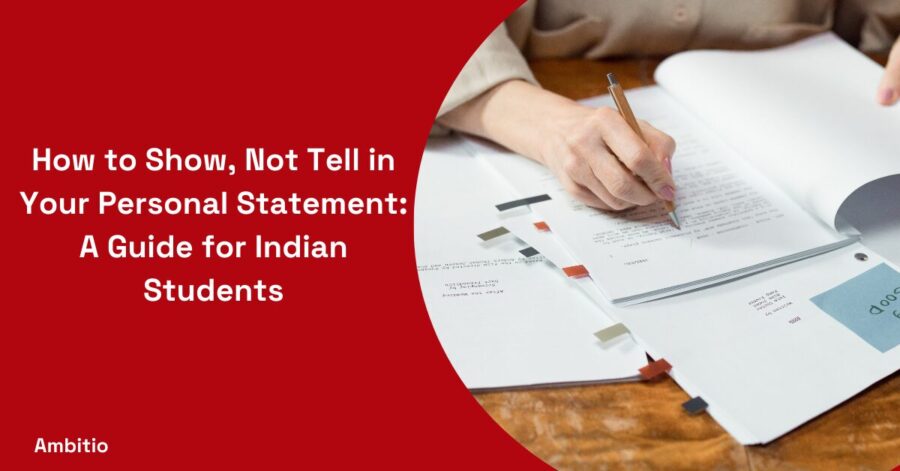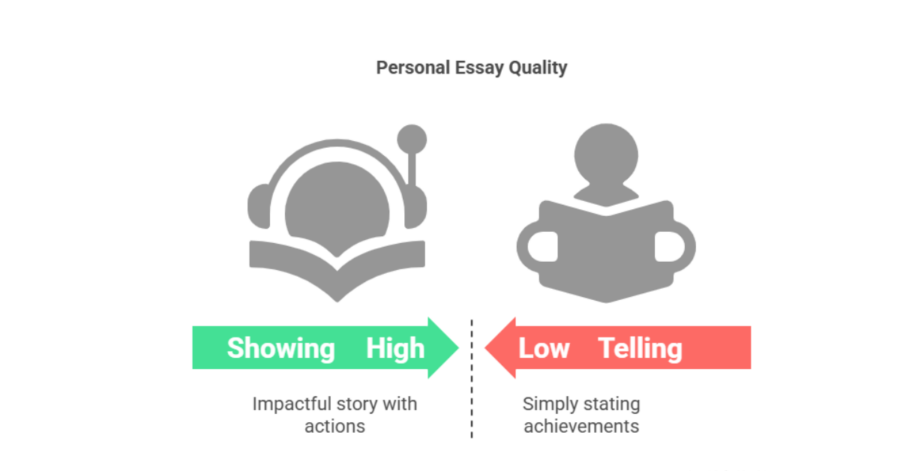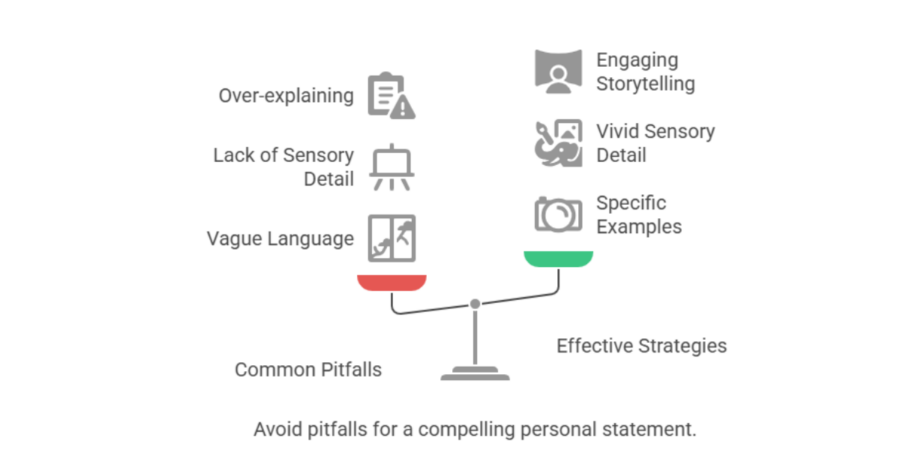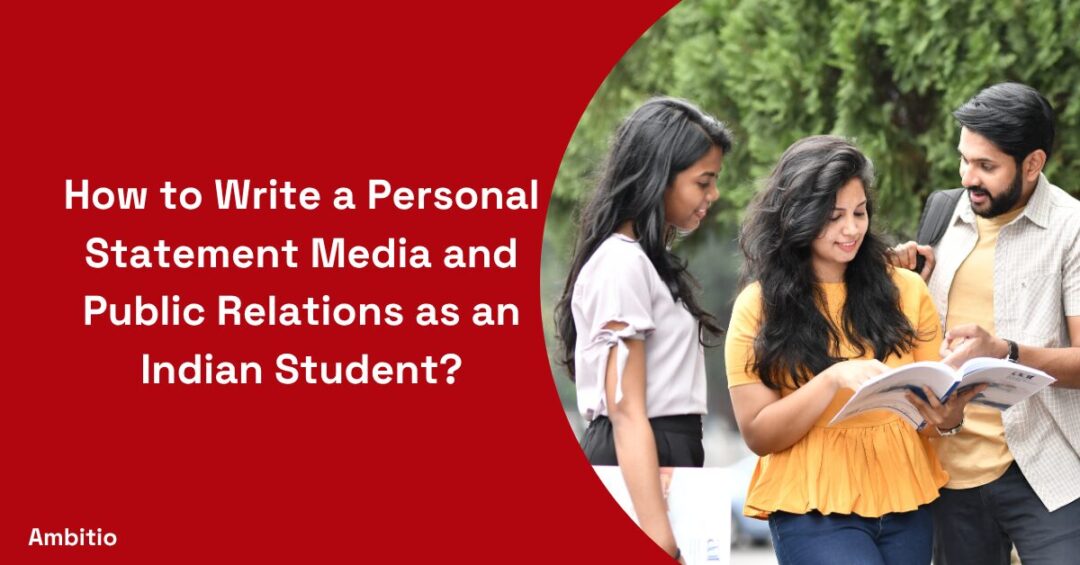6 May 2025
5 minutes read
How to Show, Not Tell in Your Personal Statement: A Perfect Guide for Indian Students

Key Takeaways:
- How to show not tell in personal statement: Use vivid examples and sensory details to engage the reader on a deeper level.
- Be Specific: Focus on clear anecdotes that demonstrate your achievements and growth.
- Revise and Edit: Ensure your draft is concise and impactful, highlighting meaningful moments.
Completing a personal statement is your opportunity to separate yourself from the other applicants to college. However, a disturbance in the space-time continuum occurs when Indian students fall into the trap of “telling” their story as opposed to “showing” it. Telling an applicant’s story via the ” telling” approach produces boring essays. Instead of merely writing what you have accomplished, the most effective way to involve the reader is to write in a way that paints a picture or allows your experiences to jump off the page.
In order to engage the admissions committee in your personal statement, you must be a master of “showing,” not telling. You will need to be adept at sensory details, metaphors, and actually using tangible examples from your life if you want to drive home the point and really connecting with the reader.
Why “Show, Don’t Tell” Matters in Personal Statements for Indian Students
A great technique to create a powerful admissions essay is to learn how to “show, not tell”. A common misstep many Indian students make when writing their essays is to tell the reader what they have achieved instead of “showing” the reader, in detail.
When you write using sensory language and include relevant anecdotes, you engage the admission committee in a way that they can visualize your experiences instead of simply reading about them. Instead of stating “I am a leader” or “I am creative”, there is a chance to show your leadership skills through an impactful story that describes your actions and growth as a leader.

The “show, don’t tell” skill is a fundamental skill of good writing and storytelling. A well-written personal essay with sensory details and dialogue shows you opening the door to the reader’s mind and allowing them to step into your world and convey how you feel and experience things.
This transforms a routine topic into a visually interesting and memorable story about you. A draft written with attention to detail and full of descriptive language can add a personal touch to your application, and create a positive impact on admissions officers.
Key Differences Between Showing and Telling in Your Personal Statement
The key difference between showing and telling in your personal statement lies in how you convey your experiences. Telling simply informs the reader by stating facts, such as “I am a good leader,” whereas showing allows the reader to experience those qualities through a vivid, meaningful story.
Instead of saying something generic, a great way to showcase your leadership is by describing a specific situation where you took charge and its impact. This strategy not only makes your college essays stand out but also provides insight that engages the reader or listener.
“Show, don’t tell” is one of the best tools in creative writing, as it adds depth and emotion to your narrative. Indian students often struggle with telling, rather than showing, in their medical school personal essays or college applications. By using vivid detail and small descriptors, you can bring your stories to life.
This method requires you to dig deep, rewrite, and revise your paragraphs to ensure each sentence has meaning. The goal is to emphasize your personal journey and let the admissions committee feel your experiences rather than just reading about them.
How to Use Specific Examples to Demonstrate Your Skills and Experiences
When it comes to writing your personal statement, one of the best ways to demonstrate your skills and experiences is by using specific examples. Rather than telling the reader about your abilities, showing them through vivid, real-life situations is a powerful strategy.
For instance, instead of saying “I am a good problem solver,” show how you solved a complex issue during a project or internship. This approach allows the admissions committee to feel your achievements, giving them a deeper sense of who you are beyond the surface-level claims.
“Show, don’t tell” is a key piece of advice for Indian students crafting their application essays. It’s crucial to avoid vague phrases or general statements that don’t add meaning. Each sentence should bring the reader into your world through small details and concise descriptions.
With careful revision, your examples will transform into powerful storytelling that conveys both your skills and self-growth. By focusing on specific, meaningful moments, you ensure your personal statement stands out and reflects your true potential in the application process.
Common Pitfalls Indian Students Face When Trying to Show, Not Tell
Writing a personal statement can be challenging for Indian students, especially when trying to master the “show, don’t tell” technique.

While it’s one of the best ways to create a compelling narrative, many applicants fall into common traps that weaken their essay. Here are a few pitfalls to avoid:
- Vague Language: Using broad phrases like “I am a leader” instead of showing specific instances where leadership was demonstrated.
- Lack of Sensory Detail: Failing to include vivid, sensory details that allow the reader to feel the experience.
- Over-explaining: Trying to tell too much, making the writing feel like a summary rather than an engaging story.
- Generic Anecdotes: Relying on common topics that don’t bring personal insight or originality to the table.
- Not Editing Enough: Overlooking revision, which is key to ensuring your examples are concise, impactful, and meaningful.
By avoiding these pitfalls, Indian students can create a powerful, unforgettable personal statement that leaves a lasting impression on admissions committees.
10 Top Universities for Study Abroad
Over 70% of admissions officers say a compelling personal statement can tip the scales between acceptance and rejection, especially when applying to the world’s top universities. But alongside strong academics and a great SOP, it’s equally crucial to understand the financial and exam requirements of your dream schools.
Here’s a comparison of 10 top universities to study abroad, with insights into average tuition fees, average graduate salary, and exams required for admission:
| University | Average Tuition Fees (per year) | Average Graduate Salary | Exams Required |
|---|---|---|---|
| Harvard University (USA) | $54,000 | $84,000 | GRE, TOEFL/IELTS, SAT (UG) |
| University of Oxford (UK) | £27,000 | £45,000 | GRE (some PG), IELTS/TOEFL |
| Stanford University (USA) | $56,000 | $95,000 | GRE, TOEFL/IELTS, SAT (UG) |
| ETH Zurich (Switzerland) | CHF 1,300 | CHF 80,000 | GRE (some), TOEFL/IELTS |
| University of Toronto (Canada) | CAD 58,000 | CAD 70,000 | GRE (some), IELTS/TOEFL, SAT |
| University of Melbourne (Australia) | AUD 45,000 | AUD 65,000 | IELTS/TOEFL, GRE (some PG) |
| University of Cambridge (UK) | £28,000 | £50,000 | GRE (some), IELTS/TOEFL |
| National University of Singapore | SGD 38,000 | SGD 60,000 | GRE (some), IELTS/TOEFL |
| University of British Columbia (CA) | CAD 52,000 | CAD 60,000 | IELTS/TOEFL, GRE/SAT |
| Massachusetts Institute of Tech (USA) | $57,000 | $102,000 | GRE, TOEFL/IELTS, SAT (UG) |
Conclusion
Mastering the “show, not tell” technique in your personal statement is essential for making a lasting impact. By providing specific examples and sensory details, Indian students can create a vivid narrative that allows the admissions committee to truly feel their story. The best advice is to focus on meaningful moments that showcase your skills and growth. Remember, the key takeaways are to be concise, authentic, and specific in your examples.
Ready to take your personal statement to the next level? Join Ambitio, where our expert team specializes in profile building and crafting compelling personal statements that open doors to top universities. Let’s make your application unforgettable!
FAQs
What does “how to show not tell in personal statement” mean?
It means using vivid examples and actions to demonstrate your qualities instead of just stating them.
Why is it important to know how to show not tell in personal statement?
Because it makes your writing more engaging and helps admissions officers connect with your story.
How can I practice how to show not tell in personal statement?
Use specific anecdotes and sensory details to illustrate your experiences clearly.
Can I use dialogue when learning how to show not tell in personal statement?
Yes, dialogue can reveal personality and emotions, making your story more vivid.
How do I check if I’m doing how to show not tell in personal statement correctly?
If readers can infer your traits without you explicitly stating them, you’re showing effectively.
Should I avoid telling completely when applying how to show not tell in personal statement?
No, balance is key; use telling for background and showing for important moments.
What’s a quick tip for mastering how to show not tell in personal statement?
Focus on describing actions and feelings through examples rather than using general statements.

You can study at top universities worldwide!
Get expert tips and tricks to get into top universities with a free expert session.
Book Your Free 30-Minute Session Now! Book a call now




























